The Effect of Green Areas on Urban Microclimate: A University Campus Model Case
Abstract
:1. Introduction
2. Materials and Methods
Data Recording and Preliminary Analysis
3. Results and Discussion
3.1. Seasonal Variations, the Impact of Green Areas, and Microclimate Improvement Potential
3.2. Regression Model and Applicability
3.3. Functional Plant Traits and Their Role in Microclimate Regulation
3.4. Practical Implications for Landscape Sustainability
3.4.1. Increasing Green Areas
3.4.2. Shading and Vertical Green Systems
3.4.3. Vegetative Design and Diversity
3.4.4. User Comfort and Space Planning
3.4.5. Future Studies and Data Monitoring
4. Conclusions
Author Contributions
Funding
Informed Consent Statement
Data Availability Statement
Acknowledgments
Conflicts of Interest
Abbreviations
| IR | Utilizes infrared |
| RSM | Response surface methodology |
| AT | Ambient temperature |
| WS | Wind speed |
| A | Surface area |
| CCD | Central composite design |
| T | Surface temperature |
References
- Kahn, M.E. Green Cities: Urban Growth and the Environment; Rowman & Littlefield: Lanham, MD, USA, 2007. [Google Scholar]
- Mensah, C.A. Destruction of urban green spaces: A problem beyond urbanization in Kumasi City (Ghana). Am. J. Environ. Prot. 2014, 3, 1–9. [Google Scholar] [CrossRef]
- Artmann, M.; Inostroza, L.; Fan, P. Urban sprawl, compact urban development and green cities. How much do we know, how much do we agree? Ecol. Indic. 2019, 96, 3–9. [Google Scholar] [CrossRef]
- Doğan, M.; Küçük, V. Gölbaşı ilçesinin açık yeşil alan durumu ve bazı yeşil alan standartlarına göre değerlendirilmesi. J. Arch. Sci. Appl. 2019, 4, 155–171. [Google Scholar]
- Wang, Y.; De Groot, R.; Bakker, F.; Wörtche, H.; Leemans, R. Thermal comfort in urban green spaces: A survey on a Dutch university campus. Int. J. Biometeorol. 2017, 61, 87–101. [Google Scholar] [CrossRef]
- Alkan, A.; Adıgüzel, F.; Kaya, E. Batman kentinde kentsel ısınmanın azaltılmasında yeşil alanların önemi. Coğrafya Derg. 2017, 34, 62–76. [Google Scholar]
- Şimşek, Ç.; Şengezer, B. İstanbul metropoliten alanında kentsel ısınmanın azaltılmasında yeşil alanların önemi. Megaron 2012, 7, 116. [Google Scholar]
- Saito, I.; Ishihara, O.; Katayama, T. Study of the effect of green areas on the thermal environment in an urban area. Energy Build. 1990, 15, 493–498. [Google Scholar] [CrossRef]
- Liu, H.L.; Shen, Y.S. The impact of green space changes on air pollution and microclimates: A case study of the Taipei Metropolitan Area. Sustainability 2014, 6, 8827–8855. [Google Scholar] [CrossRef]
- Perini, K.; Magliocco, A. Effects of vegetation, urban density, building height, and atmospheric conditions on local temperatures and thermal comfort. Urban For. Urban Green. 2014, 13, 495–506. [Google Scholar] [CrossRef]
- Santamouris, M.; Kolokotsa, D. On the impact of urban overheating and extreme climatic conditions on housing, energy, comfort and environmental quality of vulnerable population in Europe. Energy Build. 2015, 98, 125–133. [Google Scholar] [CrossRef]
- Piselli, C.; Castaldo, V.L.; Pigliautile, I.; Pisello, A.L.; Cotana, F. Outdoor comfort conditions in urban areas: On citizens’ perspective about microclimate mitigation of urban transit areas. Sustain. Cities Soc. 2018, 39, 16–36. [Google Scholar]
- Lai, D.; Liu, W.; Gan, T.; Liu, K.; Chen, Q. A review of mitigating strategies to improve the thermal environment and thermal comfort in urban outdoor spaces. Sci. Total Environ. 2019, 661, 337–353. [Google Scholar] [PubMed]
- Moradpour, M.; Hosseini, V. An investigation into the effects of green space on air quality of an urban area using CFD modeling. Urban Clim. 2020, 34, 100686. [Google Scholar] [CrossRef]
- Santamouris, M.; Osmond, P. Increasing green infrastructure in cities: Impact on ambient temperature, air quality and heat-related mortality and morbidity. Buildings 2020, 10, 233. [Google Scholar] [CrossRef]
- Liu, H.; Kong, F.; Yin, H.; Middel, A.; Zheng, X.; Huang, J.; Xu, H.; Wang, D.; Wen, Z. Impacts of green roofs on water, temperature, and air quality: A bibliometric review. Build. Environ. 2021, 196, 107794. [Google Scholar]
- Javadi, R.; Nasrollahi, N. Urban green space and health: The role of thermal comfort on the health benefits from the urban green space; A review study. Build. Environ. 2021, 202, 108039. [Google Scholar]
- Venter, Z.S.; Hassani, A.; Stange, E.; Schneider, P.; Castell, N. Reassessing the role of urban green space in air pollution control. Proc. Natl. Acad. Sci. USA 2024, 121, E2306200121. [Google Scholar]
- Hamada, S.; Ohta, T. Seasonal variations in the cooling effect of urban green areas on surrounding urban areas. Urban For. Urban Green. 2010, 9, 15–24. [Google Scholar] [CrossRef]
- Vartholomaios, A.; Kalogirou, N.; Athanassiou, E.; Papadopoulou, M. The green space factor as a tool for regulating the urban microclimate in vegetation-deprived Greek cities. In Proceedings of the International Conference on “Changing Cities”: Spatial, Morphological, Formal & Socio-Economic Dimensions, Skiathos, Greece, 18–21 June 2013; pp. 18–21. [Google Scholar]
- Yang, J.; Sun, J.; Ge, Q.; Li, X. Assessing the impacts of urbanization-associated green space on urban land surface temperature: A case study of Dalian, China. Urban For. Urban Green. 2017, 22, 1–10. [Google Scholar] [CrossRef]
- Wang, Y.; Ni, Z.; Chen, S.; Xia, B. Microclimate regulation and energy saving potential from different urban green infrastructures in a subtropical city. J. Clean. Prod. 2019, 226, 913–927. [Google Scholar]
- Priya, U.K.; Senthil, R. A review of the impact of the green landscape interventions on the urban microclimate of tropical areas. Build. Environ. 2021, 205, 108190. [Google Scholar] [CrossRef]
- Erlwein, S.; Zölch, T.; Pauleit, S. Regulating the microclimate with urban green in densifying cities: Joint assessment on two scales. Build. Environ. 2021, 205, 108233. [Google Scholar]
- Murugadoss, D.; Singh, H.; Thakur, P. Urban forests and microclimate regulation. In Urban Forests, Climate Change and Environmental Pollution; Springer: Cham, Switzerland, 2024; pp. 531–550. [Google Scholar]
- Oliveira, S.; Andrade, H.; Vaz, T. The cooling effect of green spaces as a contribution to the mitigation of urban heat: A case study in Lisbon. Build. Environ. 2011, 46, 2186–2194. [Google Scholar]
- Block, A.H.; Livesley, S.; Williams, N.S. Responding to the Urban Heat İsland: A Review of the Potential of Green İnfrastructure; Victorian Centre for Climate Change Adaptation Research: Melbourne, Australia, 2012; pp. 1–62. [Google Scholar]
- Yıldız, N.; Avdan, U. The effect of the temperature of the surface of vegetation to the temperature of an urban area. Int. J. Multidiscip. Stud. Innov. Technol. 2018, 2, 76–85. [Google Scholar]
- Rahman, M.A.; Stratopoulos, L.M.; Moser-Reischl, A.; Zölch, T.; Häberle, K.H.; Rötzer, T.; Pretzsch, H.; Pauleit, S. Traits of trees for cooling urban heat islands: A meta-analysis. Build. Environ. 2020, 170, 106606. [Google Scholar] [CrossRef]
- Speak, A.; Montagnani, L.; Wellstein, C.; Zerbe, S. The influence of tree traits on urban ground surface shade cooling. Landsc. Urban Plan. 2020, 197, 103748. [Google Scholar]
- Percival, G.C. Heat tolerance of urban tree species—A review. Urban For. Urban Green. 2023, 86, 128021. [Google Scholar]
- Thani, S.K.S.O.; Mohamad, N.H.N.; Idilfitri, S. Modification of urban temperature in hot-humid climate through landscape design approach: A review. Procedia-Soc. Behav. Sci. 2012, 68, 439–450. [Google Scholar]
- Erell, E. Urban greening and microclimate modification. In Greening Cities: Forms and Functions; Springer: Berlin/Heidelberg, Germany, 2017; pp. 73–93. [Google Scholar]
- Zou, M.; Zhang, H. Cooling strategies for thermal comfort in cities: A review of key methods in landscape design. Environ. Sci. Pollut. Res. 2021, 28, 62640–62650. [Google Scholar] [CrossRef]
- Çorbacı, Ö.L.; Abay, G.; Oğuztürk, T.; Üçok, M. Kentsel rekreasyonel alanlardaki bitki varlığı; Rize örneği. Düzce Üniversitesi Orman Fakültesi Orman. Derg. 2020, 16, 16–44. [Google Scholar]
- Shishegar, N. The impacts of green areas on mitigating urban heat island effect: A review. Int. J. Environ. Sustain. 2014, 9, 119. [Google Scholar]
- Coccolo, S.; Pearlmutter, D.; Kaempf, J.; Scartezzini, J.L. Thermal comfort maps to estimate the impact of urban greening on the outdoor human comfort. Urban For. Urban Green. 2018, 35, 91–105. [Google Scholar]
- Adıgüzel, F.; Sert, E.B.; Çetin, M. Kentsel alanda kullanılan zemin malzemelerinden kaynaklanan yüzey sıcaklığı artışının önlenmesinde ağaçların etkisinin belirlenmesi. Mustafa Kemal Univ. Tarım Bilim Derg. 2022, 27, 18–26. [Google Scholar]
- Oğuztürk, G.E.; Yüksek, T. Rainwater Management Model in Fener Campus in Recep Tayyip Erdogan University. In International Studies and Evaluations in the Field of Landscape Architecture; Seruven Publishing: Ankara, Türkiye, 2024; Volume 5, pp. 45–60. [Google Scholar]
- Ma, Y.; Jiang, Y. Ecosystem-Based Adaptation to Address Urbanization and Climate Change Challenges: The Case of China’s Sponge City Initiative. Clim. Policy 2023, 23, 268–284. [Google Scholar]
- Wu, J. Landscape sustainability science: Ecosystem services and human well-being in changing landscapes. Landsc. Ecol. 2021, 36, 2405–2431. [Google Scholar]
- Yüksek, T.; Yüksek, F. Effects of altitude, aspect, and soil depth on carbon stocks and properties of soils in a tea plantation in the humid Black Sea region. Land Degrad. Dev. 2021, 32, 4267–4276. [Google Scholar] [CrossRef]
- Mcfarland, A.L.; Waliczek, T.M.; Zajicek, J.M. The relationship between student use of campus green spaces and perceptions of quality of life. Horttechnology 2008, 18, 232–238. [Google Scholar]
- Ertekin, M.; Çorbacı, Ö.L. Üniversite kampüslerinde peyzaj tasarımı (Karabük Üniversitesi Peyzaj Projesi örneği). Kastamonu Univ. J. Fac. 2010, 10, 55–67. [Google Scholar]
- Finlay, J.; Massey, J. Eco-campus: Applying the ecocity model to develop green university and college campuses. Int. J. Sustain. High Educ. 2012, 13, 150–165. [Google Scholar] [CrossRef]
- Sonetti, G.; Lombardi, P.; Chelleri, L. True green and sustainable university campuses? Toward a clusters approach. Sustainability 2016, 8, 83. [Google Scholar] [CrossRef]
- Tudorie, C.A.M.; Vallés-Planells, M.; Gielen, E.; Arroyo, R.; Galiana, F. Towards a greener university: Perceptions of landscape services in campus open space. Sustainability 2020, 12, 6047. [Google Scholar] [CrossRef]
- Oğuztürk, G.E.; Murat, C. Termal konfor açısından Recep Tayyip Erdoğan Üniversitesi Zihni Derin Yerleşkesinin görüntü işleme yöntemleri ile analizi. Duzce Univ. Orman Fak Orman. Derg. 2023, 19, 118–128. [Google Scholar] [CrossRef]
- Ercan Oğuztürk, G.; Pulatkan, M. Evaluation of urban university campuses within the scope of sustainability; Some urban campus examples. In Landscape Research III Lyon; Livre De Lyon: Lyon, France, 2023; pp. 111–134. [Google Scholar]
- Oğuztürk, G.E.; Pulatkan, M. Interaction of urban and university campuses; KTU Kanuni Campus example. In Architectural Sciences and Urban/Environmental Studies-I; İksad Publication: Ankara, Türkiye, 2023; pp. 22–43. [Google Scholar]
- Ercan Oğuztürk, G.; Pulatkan, M. An assessment of recreational opportunities in the KTU Kanuni Campus. In Architectural Sciences and Sustainable Approaches; İksad: Ankara, Türkiye, 2024; pp. 528–546. [Google Scholar]
- Mackey, L.; Thompson, J.; Rivera, A. Urban vegetation cover and temperature correlations in mid-latitude cities: A case study in Chicago. Urban Clim. 2024, 43, 101284. [Google Scholar]
- Kloog, I.; Becker, S.; Goldstein, Y. Assessing the potential of urban green cover expansion to mitigate UHI in Tel Aviv. Environ. Res. 2024, 235, 117102. [Google Scholar]
- Boonyuen, T.; Wongwises, S.; Chankong, V. Evaluating the Microclimatic Cooling Potential of Green Roofs and Walls in Tropical Urban Areas. Environ. Res. 2024, 226, 115762. [Google Scholar]
- Needham, J.; Lopez, A.C.; Martin, C.E. Vertical canopy gradients of respiration drive plant carbon bud-gets and leaf area index. New Phytol. 2025, 235, 1021–1034. [Google Scholar] [CrossRef]
- He, L.; Wang, Y.; Zhang, Z. Growing-Season Precipitation Is a Key Driver of Plant Leaf Area to Sapwood Area. Plant Cell Environ. 2024, 47, 1123–1137. [Google Scholar]
- Liu, Y.; Zheng, H.; Wang, J. Spatial heterogeneity of LAI and its role in urban park cooling capacity. Urban For. Urban Green. 2025, 84, 127312. [Google Scholar]
- Sun, D.; Zhang, X.; Qiao, Y. Seasonal temperature regulation in relation to vegetation structure in subtropical cities. Landsc. Urban Plan. 2025, 245, 104672. [Google Scholar]
- Al-Hajri, M.; Al-Rawahi, B.; Khan, M.A. Morphological and structural traits of urban vegetation influencing microclimate in arid cities. Ecol. Indic. 2025, 154, 110872. [Google Scholar]
- Carricondo, A.; San José, R.; Pérez, J.L. Microclimatic effects of green infrastructure: A comparative simulation study. Sustain. Cities Soc. 2019, 47, 101506. [Google Scholar] [CrossRef]
- Xu, R.; Zhao, M.; Tan, H. Trait-based approaches in urban landscape cooling: A review. Urban Ecosyst. 2025, 28, 123–140. [Google Scholar]
- Pasquino, N.; De Luca, G.; Romano, D. Leaf traits and microclimate performance in Mediterranean green spaces. Environ. Res. 2025, 235, 117103. [Google Scholar]
- Zhou, Y.; Li, X.; Chen, X.; Zhang, L. Urban Green Space Morphology and Its Microclimatic Cooling Effects across Climatic Zones. Sustain. Cities Soc. 2025, 104, 105439. [Google Scholar] [CrossRef]
- Qi, W.; Shen, L.; Yu, R.; Wang, H. Assessing Urban Vegetation Cooling Efficiency under Varying Climatic Conditions: A Case Study in Yangtze River Delta. Ecol. Indic. 2025, 158, 112207. [Google Scholar] [CrossRef]
- Fricke, A.; Jiang, Y.; Wang, X. Evaluating the effects of urban green space structure on thermal comfort in Beijing. Urban For. Urban Green. 2024, 83, 127294. [Google Scholar]
- Yıldız, N.E. Üniversite Yerleşkelerinde Ekolojik Peyzaj Tasarımı: Niğde Ömer Halisdemir Üniversitesi Örneği. J. Soc. Humanit. Sci. Res. 2020, 7, 3594–3604. [Google Scholar]
- Bilgili, B.C.; Gökyer, E.; Özyavuz, M.; Çorbacı, Ö.L. Peyzaj Tasarımında Coğrafi Bilgi Sistemleri Kullanımının Değerlendirilmesi: Çankırı Karatekin Üniversite Yerleşkesi Örneği. Düzce Üniv. Orman Fak. Orman. Derg. 2018, 14, 1–16. [Google Scholar]
- Shashua-Bar, L.; Tsiros, I.X.; Hoffman, M.E. Passive cooling design in urban spaces: The case of shading by trees. Energy Build. 2011, 43, 2347–2355. [Google Scholar] [CrossRef]
- Dimoudi, A.; Nikolopoulou, M. Vegetation in the urban environment: Microclimatic analysis and benefits. Energy Build. 2003, 35, 69–76. [Google Scholar] [CrossRef]
- Sun, L.; Xie, C.; Qin, Y.; Zhou, R.; Wu, H.; Che, S. Study on temperature regulation function of green spaces at community scale in high-density urban areas and planning design strategies. Urban For. Urban Green. 2024, 101, 128511. [Google Scholar]
- Liu, Y.; Zhu, W. Time-dependent effects of urban green spaces on microclimate regulation. Sustain. Cities Soc. 2023, 96, 104657. [Google Scholar] [CrossRef]
- Aussenac, G. Interactions between forest stands and microclimate: Ecophysiological aspects and consequences for silviculture. Ann. Sci. 2000, 57, 287–301. [Google Scholar]
- Singh, A.K.; Pravesh Kumar, P.K.; Renu Singh, R.S.; Nidhi Rathore, N.R. Dynamics of tree-crop interface in relation to their influence on microclimatic changes—A review. HortFlora Res. Spect. 2012, 1, 193–198. [Google Scholar]
- Charrier, G.; Ngao, J.; Saudreau, M.; Améglio, T. Effects of environmental factors and management practices on microclimate, winter physiology, and frost resistance in trees. Front. Plant Sci. 2015, 6, 259. [Google Scholar]
- Gill, S.E.; Handley, J.F.; Ennos, A.R.; Pauleit, S. Adapting cities for climate change: The role of the green infrastructure. Built Environ. 2007, 33, 115–133. [Google Scholar]
- Cordeiro, A.; Ornelas, A.; Lameiras, J.M. The thermal regulator role of urban green spaces: The case of Coimbra (Portugal). Forests 2023, 14, 2351. [Google Scholar] [CrossRef]
- Wang, S.; Sun, C.; Huang, L.; Shi, H.; Xu, X.; Han, D.; Gu, Q.; Liu, H. The diurnal cooling effect of green space structure on the summer urban thermal environment from a high-resolution perspective. IEEE J. Sel. Top. Appl. Earth Obs. Remote Sens. 2024, 17, 19943–19954. [Google Scholar]
- Wong, N.H.; Yu, C. Study of green areas and urban heat island in a tropical city. Habitat. Int. 2005, 29, 547–558. [Google Scholar]
- Park, J.; Kim, J.H.; Lee, D.K.; Park, C.Y.; Jeong, S.G. The influence of small green space type and structure at the street level on urban heat island mitigation. Urban For. Urban Green. 2017, 21, 203–212. [Google Scholar]
- Wang, C.; Ren, Z.; Dong, Y.; Zhang, P.; Guo, Y.; Wang, W.; Bao, G. Efficient cooling of cities at global scale using urban green space to mitigate urban heat island effects in different climatic regions. Urban For. Urban Green. 2022, 74, 127635. [Google Scholar] [CrossRef]
- Marando, F.; Heris, M.P.; Zulian, G.; Udías, A.; Mentaschi, L.; Chrysoulakis, N.; Parastatidis, D.; Maes, J. Urban heat island mitigation by green infrastructure in European Functional Urban Areas. Sustain. Cities Soc. 2022, 77, 103564. [Google Scholar] [CrossRef]
- Abdulateef, M.F.; Al-Alwan, H.A. The effectiveness of urban green infrastructure in reducing surface urban heat island. Ain Shams Eng. J. 2022, 13, 101526. [Google Scholar]
- Alemu, M.M.; Tadesse, A.A.; Gizaw, M.F. Spatial connectivity of green infrastructure and its cooling impact in rapidly urbanizing cities: A case from Addis Ababa. Ecol. Indic. 2024, 153, 110850. [Google Scholar]
- Fricke, S.; Mekonnen, A.; Alemayehu, F.; Gebre, H. Urban Green Infrastructure and Thermal Comfort in Sub-Saharan African Cities: A Study from Addis Ababa. Urban Clim. 2024, 50, 101691. [Google Scholar] [CrossRef]
- Nielsen, D.C.; Vigil, M.F. Canopy cover and leaf area index relationships for wheat, triticale, and corn. Agron. J. 2012, 104, 1339–1346. [Google Scholar] [CrossRef]
- Mullen, M.E.; Petrovic, A.M. Ground cover management and soil moisture in urban green infrastructures. Ecol. Eng. 2025, 191, 107635. [Google Scholar]
- Amanullah, M.M.; Muthukrishnan, P.; Vaiyapuri, K.; Sathyamoorthi, K. Influence of organic manures on growth, yield and quality of medicinal plant Andrographis paniculata. Res. J. Agric. Biol. Sci. 2007, 3, 252–255. [Google Scholar]
- Karadayı, B.; Erdem, R.; Kaya, G. Assessing the impact of urban tree morphological traits on microclimate regulation under heat stress conditions. Sustainability 2024, 16, 6527. [Google Scholar]
- Liu, R.; Zhu, J. The role of canopy structure and plant physiological traits in urban heat mitigation: A remote sensing perspective. Ecol. Indic. 2024, 163, 113844. [Google Scholar]
- Zhang, W.; Liu, X. Understanding transpiration-driven cooling in dense urban forests: Implications for plant selection in climate-resilient cities. Urban Clim. 2024, 53, 101332. [Google Scholar]
- Liu, Y.; Zhu, H. Evaluating the spatial distribution of urban green spaces and their influence on thermal comfort in rapidly urbanizing cities. Environ. Sci. Pollut. Res. 2024, 31, 10153–10168. [Google Scholar]
- Sun, H.; Wang, L.; Chen, Y. Integrating vegetation into compact city design to enhance long-term climate resilience. Sci. Total Environ. 2024, 922, 171038. [Google Scholar] [CrossRef]
- Li, X.; Zhang, H.; Yang, W. Estimation of Forest Leaf Area Index Based on GEE Data Fusion Method. Remote Sens. 2025, 17, 1147. [Google Scholar]
- Espinosa del Alba, E. Microclimatic variation regulates seed germination phenology in alpine grasslands. J. Ecol. 2025, 113, 249–262. [Google Scholar] [CrossRef]

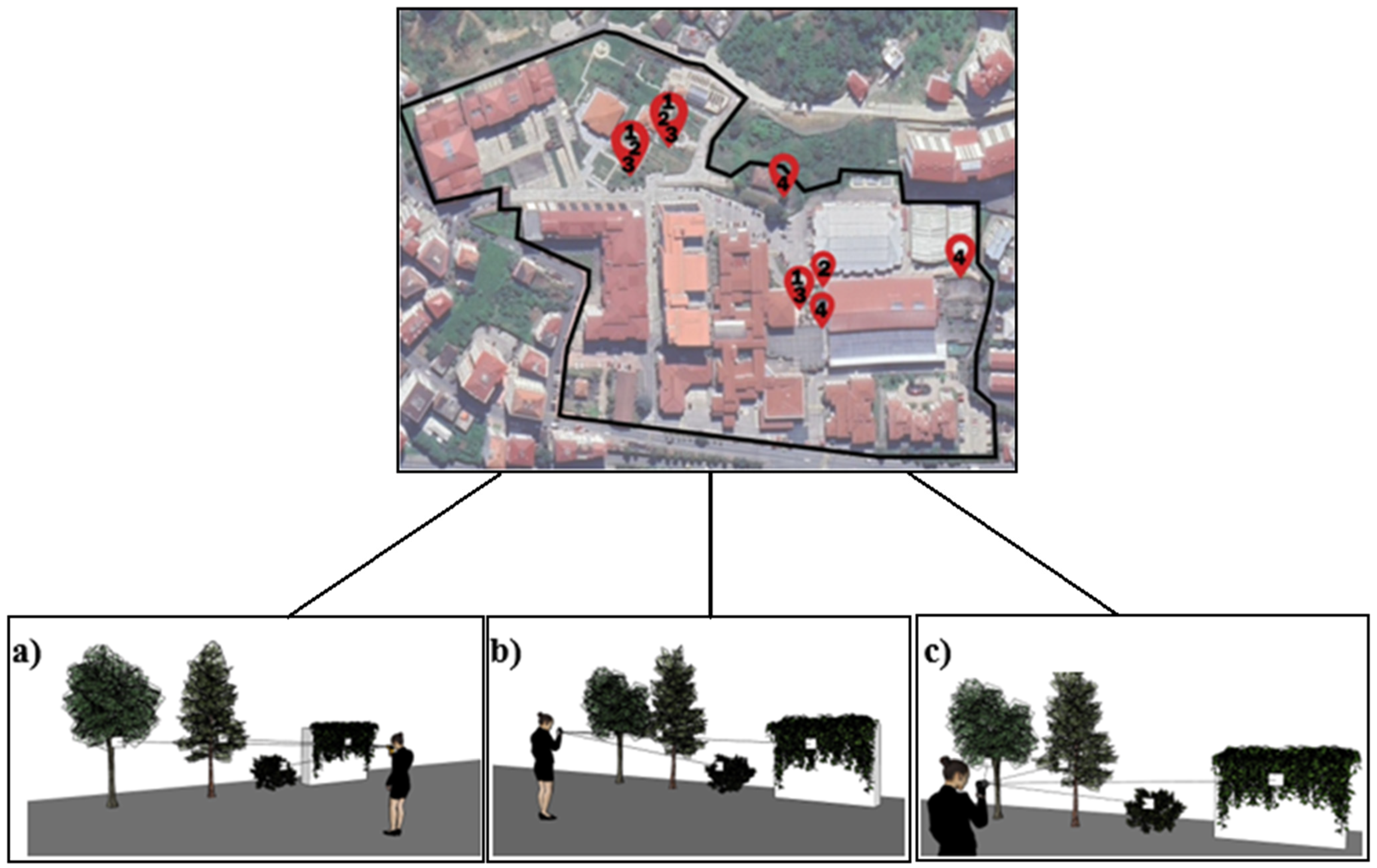
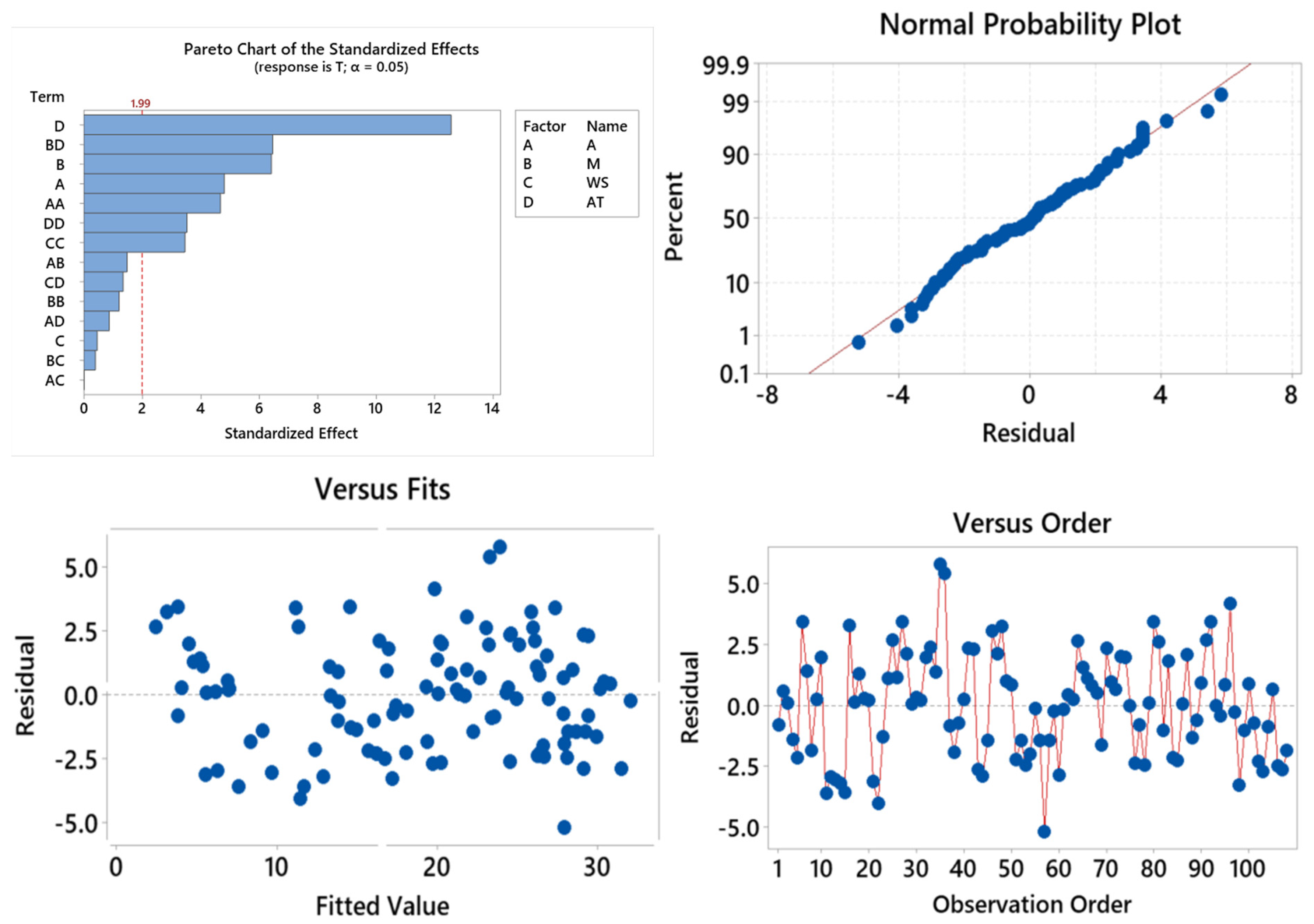
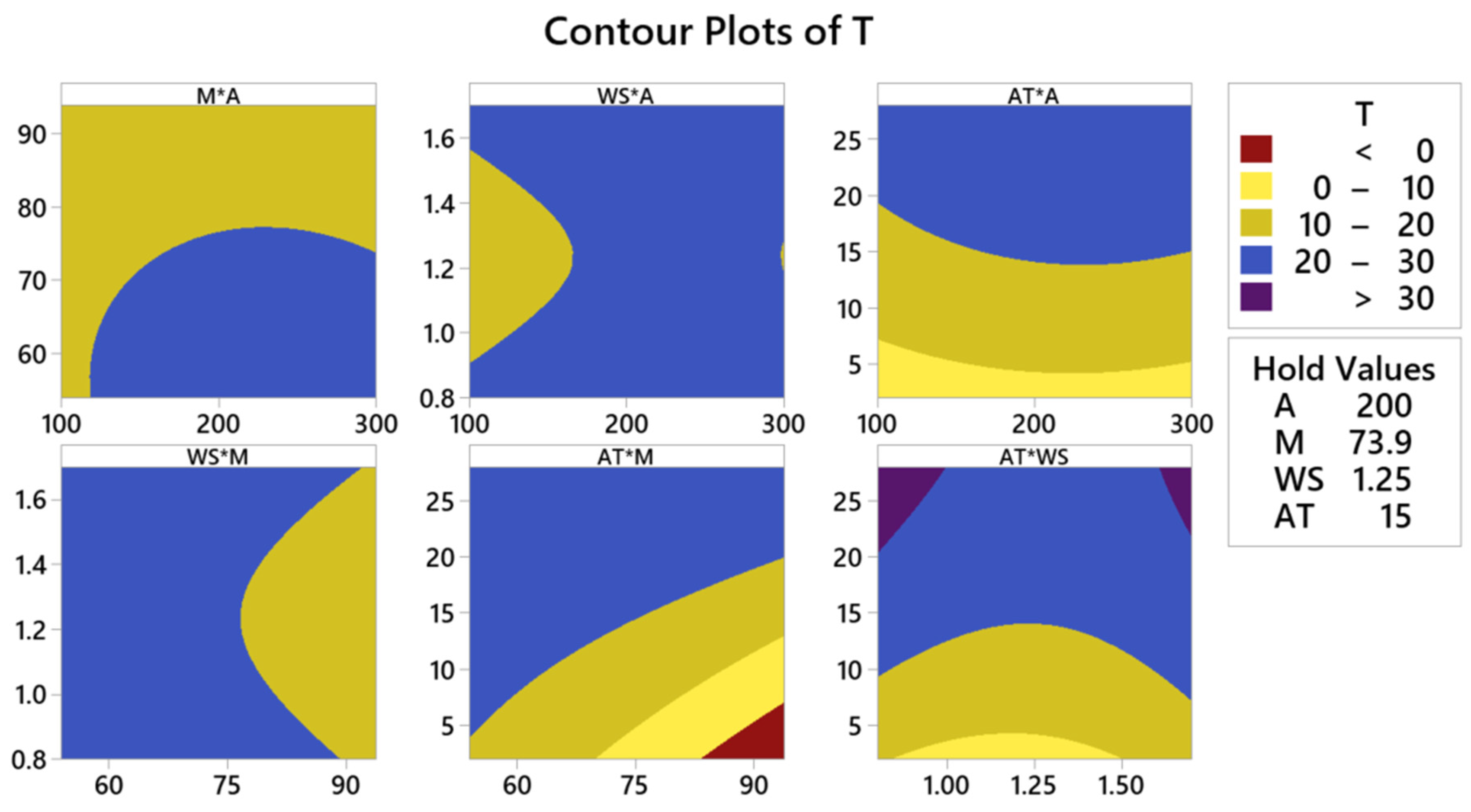
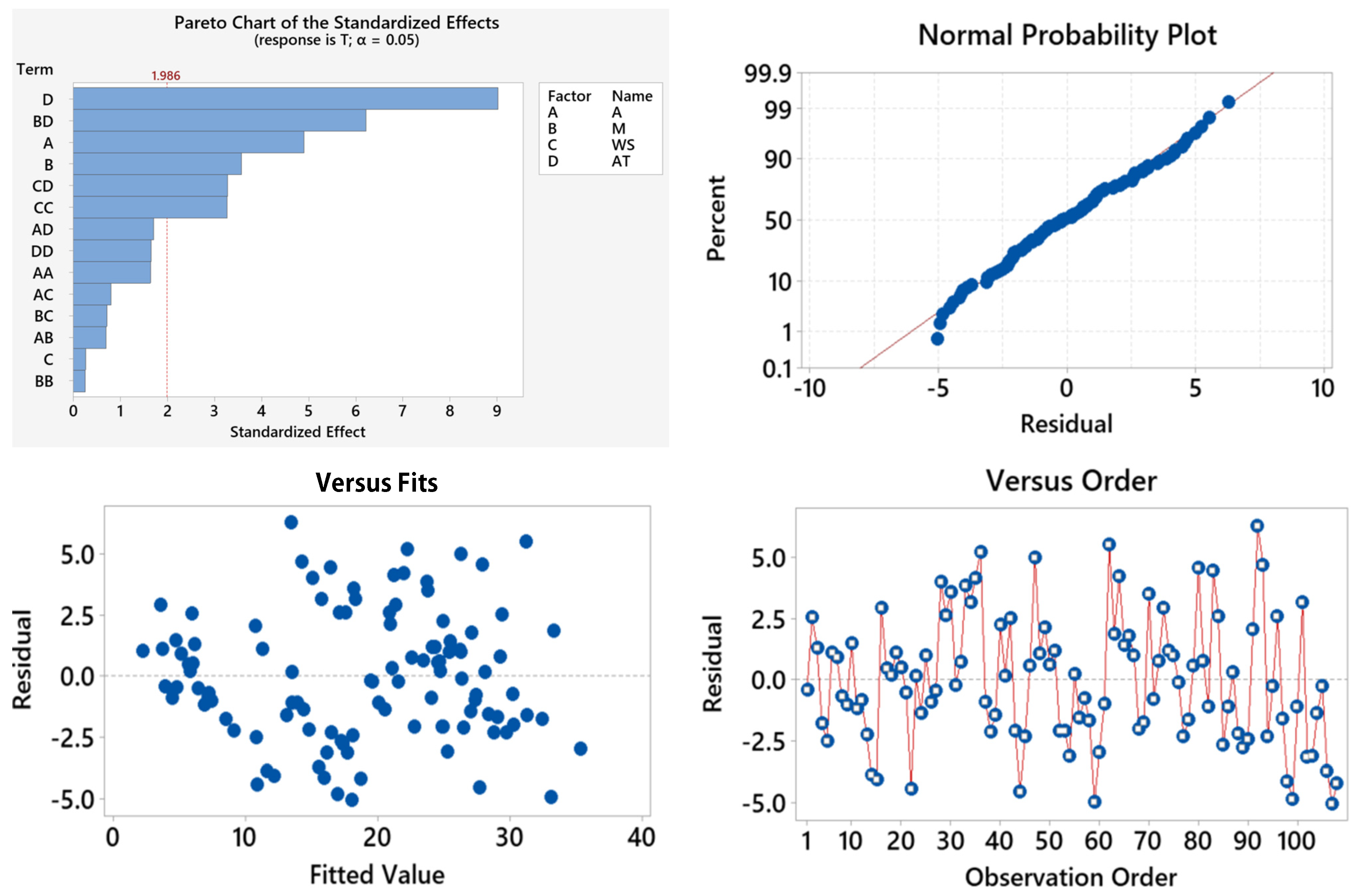
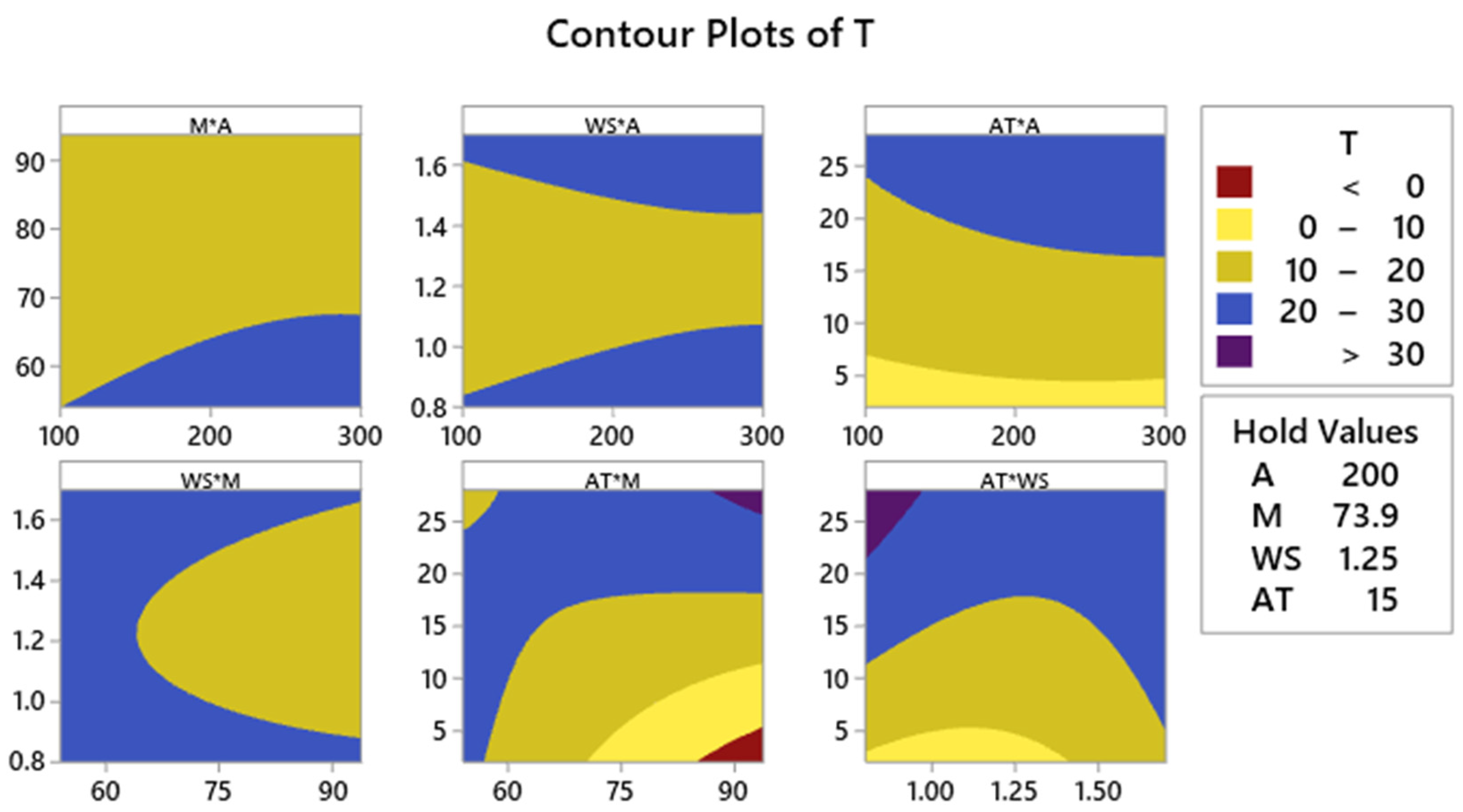
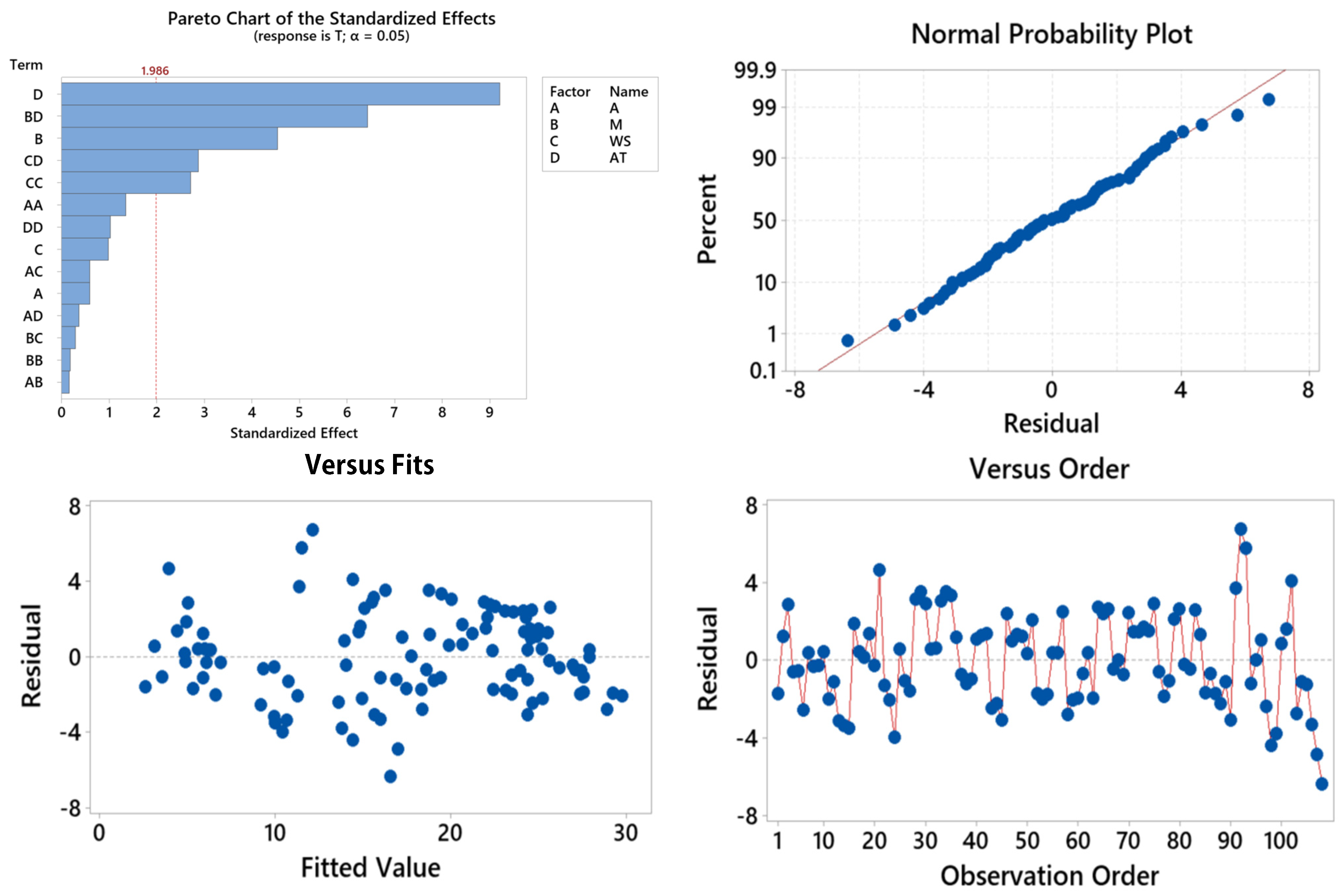


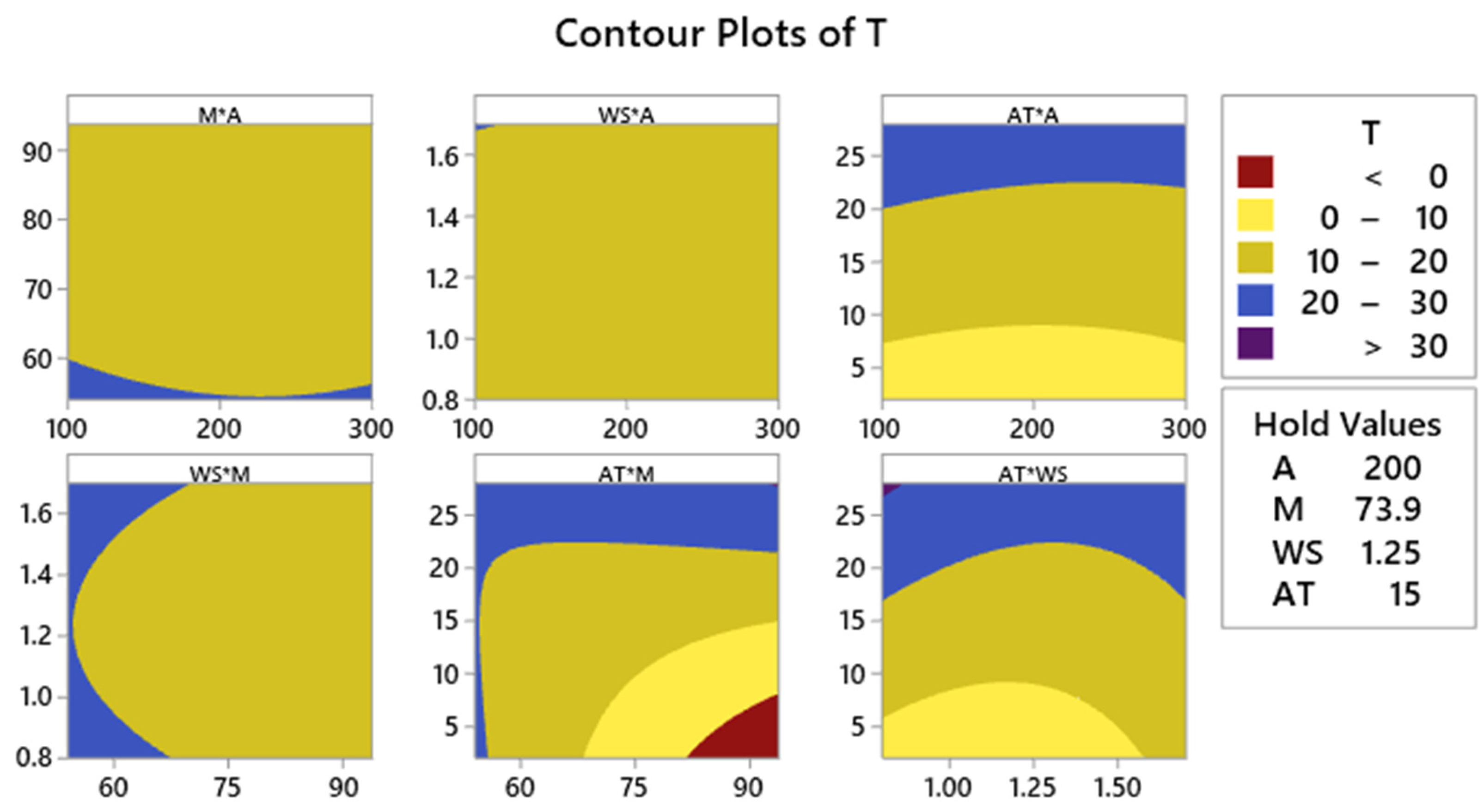
| Source | DF | Contribution | Adj SS | Adj MS | F-Value | p-Value | VIF |
|---|---|---|---|---|---|---|---|
| Model | 14 | 93.51% | 7278.84 | 519.917 | 95.71 | 0.0000 | |
| Linear | 4 | 85.59% | 1193.49 | 298.374 | 54.92 | 0.0000 | |
| A (m2) | 1 | 1.69% | 125.56 | 125.561 | 23.11 | 0.0000 | 1.17 |
| M (%) | 1 | 7.76% | 224.17 | 224.170 | 41.27 | 0.0000 | 3.47 |
| WS (m/s) | 1 | 6.01% | 1.14 | 1.143 | 0.21 | 0.6475 | 4.63 |
| AT (°C) | 1 | 70.14% | 859.27 | 859.268 | 158.17 | 0.0000 | 4.02 |
| Square | 4 | 4.44% | 250.21 | 62.553 | 11.51 | 0.0000 | |
| A×A | 1 | 1.53% | 118.82 | 118.815 | 21.87 | 0.0000 | 1.00 |
| M×M | 1 | 1.25% | 7.94 | 7.938 | 1.46 | 0.2298 | 7.65 |
| WS×WS | 1 | 0.18% | 65.16 | 65.159 | 11.99 | 0.0008 | 5.41 |
| AT×AT | 1 | 1.48% | 67.85 | 67.854 | 12.49 | 0.0006 | 1.79 |
| 2-Way Interaction | 6 | 3.48% | 270.55 | 45.092 | 8.30 | 0.0000 | |
| A×M | 1 | 0.18% | 11.93 | 11.928 | 2.20 | 0.1418 | 1.13 |
| A×WS | 1 | 0.00% | 0.00 | 0.001 | 0.00 | 0.9881 | 1.25 |
| A×AT | 1 | 0.05% | 4.11 | 4.115 | 0.76 | 0.3864 | 1.06 |
| M×WS | 1 | 0.20% | 0.85 | 0.850 | 0.16 | 0.6934 | 3.79 |
| M×AT | 1 | 2.91% | 227.22 | 227.223 | 41.83 | 0.0000 | 2.11 |
| WS×AT | 1 | 0.13% | 9.81 | 9.808 | 1.81 | 0.1823 | 4.18 |
| Error | 93 | 6.49% | 505.21 | 5.432 | |||
| Total | 107 | 100.00% | |||||
| Model Summary | |||||||
| S | R-sq | R-sq (adj) | R-sq (pred) | ||||
| 2.33075 | 93.51% | 92.53% | 91.12% | ||||
| Source | DF | Contribution | Adj SS | Adj MS | F-Value | p-Value | VIF |
|---|---|---|---|---|---|---|---|
| Model | 14 | 91.40% | 7720.51 | 551.465 | 70.58 | 0.000 | |
| Linear | 4 | 82.96% | 919.53 | 229.883 | 29.42 | 0.000 | |
| A (m2) | 1 | 2.94% | 187.16 | 187.164 | 23.95 | 0.000 | 1.17 |
| M (%) | 1 | 4.65% | 99.35 | 99.350 | 12.72 | 0.001 | 3.47 |
| WS (m/s) | 1 | 5.55% | 0.51 | 0.510 | 0.07 | 0.799 | 4.63 |
| AT (°C) | 1 | 69.82% | 635.11 | 635.111 | 81.28 | 0.000 | 4.02 |
| Square | 4 | 3.56% | 242.56 | 60.641 | 7.76 | 0.000 | |
| A×A | 1 | 0.25% | 20.84 | 20.844 | 2.67 | 0.106 | 1.00 |
| M×M | 1 | 2.41% | 0.49 | 0.492 | 0.06 | 0.802 | 7.65 |
| WS×WS | 1 | 0.29% | 82.98 | 82.979 | 10.62 | 0.002 | 5.41 |
| AT×AT | 1 | 0.62% | 21.36 | 21.358 | 2.73 | 0.102 | 1.79 |
| 2-Way Interaction | 6 | 4.88% | 411.90 | 68.649 | 8.79 | 0.000 | |
| A×M | 1 | 0.01% | 3.74 | 3.743 | 0.48 | 0.491 | 1.13 |
| A×WS | 1 | 0.02% | 5.00 | 4.998 | 0.64 | 0.426 | 1.25 |
| A×AT | 1 | 0.27% | 22.67 | 22.665 | 2.90 | 0.092 | 1.06 |
| M×WS | 1 | 0.05% | 3.90 | 3.897 | 0.50 | 0.482 | 3.79 |
| M×AT | 1 | 3.54% | 301.16 | 301.160 | 38.54 | 0.000 | 2.11 |
| WS×AT | 1 | 0.99% | 83.65 | 83.647 | 10.71 | 0.001 | 4.18 |
| Error | 93 | 8.60% | 726.67 | 7.814 | |||
| Total | 107 | 100.00% | 8447.17 | ||||
| Model Summary | |||||||
| S | R-sq | R-sq (adj) | R-sq (pred) | ||||
| 2.79528 | 91.40% | 90.10% | 88.76% | ||||
| Source | DF | Contribution | Adj SS | Adj MS | F-Value | p-Value | VIF |
|---|---|---|---|---|---|---|---|
| Model | 14 | 91.26% | 6182.65 | 441.618 | 69.34 | 0.000 | |
| Linear | 4 | 83.62% | 674.25 | 168.561 | 26.47 | 0.000 | |
| A (m2) | 1 | 0.02% | 2.19 | 2.188 | 0.34 | 0.559 | 1.17 |
| M (%) | 1 | 5.50% | 131.09 | 131.093 | 20.58 | 0.000 | 3.47 |
| WS (m/s ) | 1 | 7.75% | 6.13 | 6.133 | 0.96 | 0.329 | 4.63 |
| AT (°C) | 1 | 70.34% | 540.83 | 540.835 | 84.92 | 0.000 | 4.02 |
| Square | 4 | 2.81% | 132.96 | 33.239 | 5.22 | 0.001 | |
| A×A | 1 | 0.17% | 11.64 | 11.639 | 1.83 | 0.180 | 1.00 |
| M×M | 1 | 2.11% | 0.20 | 0.196 | 0.03 | 0.861 | 7.65 |
| WS×WS | 1 | 0.15% | 46.62 | 46.619 | 7.32 | 0.008 | 5.41 |
| AT×AT | 1 | 0.38% | 6.70 | 6.698 | 1.05 | 0.308 | 1.79 |
| 2-Way Interaction | 6 | 4.83% | 327.20 | 54.534 | 8.56 | 0.000 | |
| A×M | 1 | 0.01% | 0.15 | 0.155 | 0.02 | 0.876 | 1.13 |
| A×WS | 1 | 0.04% | 2.19 | 2.191 | 0.34 | 0.559 | 1.25 |
| A×AT | 1 | 0.01% | 0.81 | 0.814 | 0.13 | 0.722 | 1.06 |
| M×WS | 1 | 0.12% | 0.52 | 0.518 | 0.08 | 0.776 | 3.79 |
| M×AT | 1 | 3.86% | 263.35 | 263.346 | 41.35 | 0.000 | 2.11 |
| WS×AT | 1 | 0.78% | 52.59 | 52.587 | 8.26 | 0.005 | 4.18 |
| Error | 93 | 8.74% | 592.28 | 6.369 | |||
| Total | 107 | 100.00% | 6774.93 | ||||
| Model Summary | |||||||
| S | R-sq | R-sq (adj) | R-sq (pred) | ||||
| 2.52360 | 91.26% | 89.94% | 88.58% | ||||
| Source | DF | Contribution | Adj SS | Adj MS | F-Value | p-Value | VIF |
|---|---|---|---|---|---|---|---|
| Model | 14 | 92.49% | 7285.66 | 520.404 | 81.76 | 0.000 | |
| Linear | 4 | 84.67% | 983.13 | 245.782 | 38.61 | 0.000 | |
| A (m2) | 1 | 0.20% | 13.00 | 12.997 | 2.04 | 0.156 | 1.17 |
| M (%) | 1 | 7.87% | 222.51 | 222.509 | 34.96 | 0.000 | 3.47 |
| WS (m/s ) | 1 | 5.15% | 1.31 | 1.314 | 0.21 | 0.651 | 4.63 |
| AT (°C) | 1 | 71.45% | 762.82 | 762.820 | 119.84 | 0.000 | 4.02 |
| Square | 4 | 3.82% | 183.96 | 45.989 | 7.22 | 0.000 | |
| A×A | 1 | 0.40% | 31.13 | 31.130 | 4.89 | 0.029 | 1.00 |
| M×M | 1 | 3.05% | 0.98 | 0.977 | 0.15 | 0.696 | 7.65 |
| WS×WS | 1 | 0.38% | 43.03 | 43.034 | 6.76 | 0.011 | 5.41 |
| AT×AT | 1 | 0.00% | 6.01 | 6.010 | 0.94 | 0.334 | 1.79 |
| 2-Way Interaction | 6 | 3.99% | 314.28 | 52.380 | 8.23 | 0.000 | |
| A×M | 1 | 0.02% | 0.41 | 0.412 | 0.06 | 0.800 | 1.13 |
| A×WS | 1 | 0.00% | 0.92 | 0.919 | 0.14 | 0.705 | 1.25 |
| A×AT | 1 | 0.15% | 11.82 | 11.818 | 1.86 | 0.176 | 1.06 |
| M×WS | 1 | 0.17% | 0.04 | 0.039 | 0.01 | 0.938 | 3.79 |
| M×AT | 1 | 3.30% | 261.09 | 261.094 | 41.02 | 0.000 | 2.11 |
| WS×AT | 1 | 0.35% | 27.91 | 27.912 | 4.38 | 0.039 | 4.18 |
| Error | 93 | 7.51% | 591.98 | 6.365 | |||
| Total | 107 | 100.00% | 7877.64 | ||||
| Model Summary | |||||||
| S | R-sq | R-sq (adj) | R-sq (pred) | ||||
| 2.52297 | 92.49% | 91.35% | 89.93% | ||||
Disclaimer/Publisher’s Note: The statements, opinions and data contained in all publications are solely those of the individual author(s) and contributor(s) and not of MDPI and/or the editor(s). MDPI and/or the editor(s) disclaim responsibility for any injury to people or property resulting from any ideas, methods, instructions or products referred to in the content. |
© 2025 by the authors. Licensee MDPI, Basel, Switzerland. This article is an open access article distributed under the terms and conditions of the Creative Commons Attribution (CC BY) license (https://creativecommons.org/licenses/by/4.0/).
Share and Cite
Ercan Oğuztürk, G.; Sünbül, S.; Alparslan, C. The Effect of Green Areas on Urban Microclimate: A University Campus Model Case. Appl. Sci. 2025, 15, 4358. https://doi.org/10.3390/app15084358
Ercan Oğuztürk G, Sünbül S, Alparslan C. The Effect of Green Areas on Urban Microclimate: A University Campus Model Case. Applied Sciences. 2025; 15(8):4358. https://doi.org/10.3390/app15084358
Chicago/Turabian StyleErcan Oğuztürk, Gülcay, Sude Sünbül, and Cem Alparslan. 2025. "The Effect of Green Areas on Urban Microclimate: A University Campus Model Case" Applied Sciences 15, no. 8: 4358. https://doi.org/10.3390/app15084358
APA StyleErcan Oğuztürk, G., Sünbül, S., & Alparslan, C. (2025). The Effect of Green Areas on Urban Microclimate: A University Campus Model Case. Applied Sciences, 15(8), 4358. https://doi.org/10.3390/app15084358






